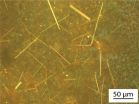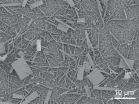(Press-News.org) MADISON, Wis. - Take a material that is a focus of interest in the quest for advanced solar cells. Discover a "freshman chemistry level" technique for growing that material into high-efficiency, ultra-small lasers. The result, disclosed today [Monday, April 13] in Nature Materials, is a shortcut to lasers that are extremely efficient and able to create many colors of light.
That makes these tiny lasers suitable for miniature optoelectronics, computers and sensors.
"We are working with a class of fascinating materials called organic-inorganic hybrid perovskites that are the focus of attention right now for high-efficiency solar cells that can be made from solution processes," says Song Jin, a professor of chemistry at the University of Wisconsin-Madison.
"While most researchers make these perovskite compounds into thin films for the fabrication of solar cells, we have developed an extremely simple method to grow them into elongated crystals that make extremely promising lasers," Jin says. The tiny rectangular crystals grown in Jin's lab are about 10 to 100 millionths of a meter long by about 400 billionths of a meter (nanometers) across. Because their cross-section is measured in nanometers, these crystals are called nanowires.
The new growth technique skips the costly, complicated equipment needed to make conventional lasers, says Jin, an expert on crystal growth and nanomaterial synthesis.
Jin says the nanowires grow in about 20 hours once a glass plate coated with a solid reactant is submerged in a solution of the second reactant. "There's no heat, no vacuum, no special equipment needed," says Jin. "They grow in a beaker on the lab bench."
"The single-crystal perovskite nanowires grown from solutions at room temperature are high quality, almost free of defects, and they have the nice reflective parallel facets that a laser needs," Jin explains. "Most importantly, according to the conventional measures of lasing quality and efficiency, they are real standouts."
When tested in the lab of Jin's collaborator, Xiaoyang Zhu of Columbia University, the lasers were nearly 100 percent efficient. Essentially every photon absorbed produced a photon of laser light. "The advantage of these nanowire lasers is the much higher efficiency, by at least one order of magnitude, over existing ones," says Zhu.
Lasers are devices that make coherent, pure-color light when stimulated with energy. "Coherent" means the light waves are moving synchronously, with their high and low points occurring at the same place. Coherence and the single-wavelength, pure color give lasers their most valuable properties. Lasers are used everywhere from DVD players, optical communications and surgery to cutting metal.
Nanowire lasers have the potential to enhance efficiency and miniaturize devices, and could be used in devices that merge optical and electronic technology for computing, communication and sensors.
"These are simply the best nanowire lasers by all performance criteria," says Jin, "even when compared to materials grown in high temperature and high vacuum. Perovskites are intrinsically good materials for lasing, but when they are grown into high-quality crystals with the proper size and shape, they really shine."
What is also exciting is that simply tweaking the recipe for growing the nanowires could create a series of lasers that emit a specific wavelength of light in many areas of the visible spectrum.
Before these nanowire lasers can be used in practical applications, Jin says their chemical stability must be improved. Also important is finding a way to stimulate the laser with electricity rather than light, which was just demonstrated.
INFORMATION:
The collaborative research was funded by the U.S. Department of Energy Basic Energy Sciences program. Graduate student Yongping Fu designed, synthesized and characterized the perovskite nanowires in Jin's lab in Madison. Haiming Zhu, a postdoctoral researcher in Zhu's lab at Columbia, carried out the optical studies of those nanowires and established their remarkable lasing properties.
David Tenenbaum
608-265-8549
djtenenb@wisc.edu
Neonatal abstinence syndrome (NAS), a drug withdrawal syndrome in infants following birth, has historically been associated with illicit drug use among pregnant women.
But a study by a team at Vanderbilt University Medical Center shows that pregnant women are commonly being prescribed opioids -- narcotic pain relievers such as hydrocodone -- which results in an increased likelihood of NAS. In addition, the study found that opioid type and duration of exposure combined with tobacco use or selective serotonin reuptake inhibitor use (for treating depression and anxiety) ...
ARGONNE, Ill. - Scientists have developed a new approach that combines ptychographic X-ray imaging and fluorescence microscopy to study the important role trace elements play in biological functions on hydrated cells.
A team of researchers using the Advanced Photon Source, a U.S. Department of Energy Office of Science User Facility at Argonne National Laboratory, demonstrated unparalleled sensitivity for measuring the distribution of trace elements in thicker specimens at cryogenic temperatures, in this case at about 260 degrees below Fahrenheit.
Trace metals are important ...
JACKSONVILLE, Fla. -- When people find out -- usually from a diagnostic scan looking at something else -- that they have a lesion in their pancreas that could morph into pancreatic cancer, they can panic. They insist on having frequent CT scans and biopsies to monitor the lesion, or they ask for surgery. Physicians also don't know if these abnormalities are dangerous, so the patients end up in surgery having part of their pancreas removed. Often the lesion is nothing to worry about.
But a team of international physicians, led by researchers at Mayo Clinic's campus in ...
Scientists from the Growth Factors, Nutrients and Cancer Group at the Spanish National Cancer Research Center (CNIO), led by Nabil Djouder, have discovered that the MCRS1 protein, in response to an excess of nutrients, induces an increase in the activity of mTOR (the mammalian/mechanistic Target of Rapamycin); a protein that is altered in human diseases such as cancer and diabetes, processes associated with ageing, as well as in certain cardiovascular and neurodegenerative pathologies. The finding, published in the journal Developmental Cell, opens up new possibilities ...
(Washington, D.C.) - According to financial planners, women face unique challenges when preparing to retire. A recent study co-authored by Robin Lumsdaine, Crown Prince of Bahrain Professor of International Finance at American University's Kogod School of Business, reveals retirement-age women who have new grandchildren are 9 percent more likely to retire early than those who do not. The increased probability of early retirement due to the arrival of grandchildren is comparable to the number of women that retire due to worsening health. The decision to retire early has ...
(WASHINGTON - April 13, 2015) - New research published online today in Blood, the Journal of the American Society of Hematology (ASH), reports that children with "bubble boy disease" who undergo gene therapy have fewer infections and hospitalizations than those receiving stem cells from a partially matched donor. The research is the first to compare outcomes among children with the rare immune disorder - also known as X-linked severe combined immunodeficiency (SCID-X1) - receiving the two therapeutic approaches.
Children with SCID-X1 are born with a genetic defect that ...
WASHINGTON, April 13, 2015 -- Ever run out of your go-to cleaning product, and you've got a mess that you just can't leave alone? Have no fear, chemistry is here. Reactions is back with another round of our Chemistry Life Hacks series, and this week it's all about cleaning. Learn how to make your own glass cleaner, keep red wine from staining your carpet and why spit, yes spit, can also be a great cleaning product. Check out the video here: https://youtu.be/IpG3VClxO3c.
INFORMATION:Subscribe to the series at http://bit.ly/ACSReactions, and follow us on Twitter @ACSreactions ...
The recent increase in popularity of marijuana use coupled with more liberal state-level polices has begun to change the landscape of adolescent marijuana use. More potent forms of marijuana, such as hashish, may present a threat to adolescent health. A wealth of research has been conducted to examine risk factors for teen marijuana use; however, studies rarely differentiate between different forms of marijuana.
A new study by researchers affiliated with New York University's Center for Drug Use and HIV Research (CDUHR), was among the first to examine prevalence and correlates ...
Air pollution and smog have health consequences for affected populations ranging from respiratory problems to death. Fine particulate matter especially has become the focus in recent years, because it increases the probability of dying from respiratory or cardiovascular disease. In addition, the risk of stroke is increased, as shown by Barbara Hoffmann and her coauthors in a recent study in Deutsches Ärzteblatt International (Dtsch Arztebl Int 2015; 112: 195-201). In a population of the German Ruhr region, she investigated how often stroke and cardiovascular disease ...
An international team, including researchers at the University of Liverpool, have shown that south east Iceland is underlain by continental crust.
The team found that the accepted theory, that Iceland consists only of very thick oceanic crust, is incorrect. Maps of crustal thickness produced from satellite gravity data, together with geochemical, plate tectonic reconstruction and mantle plume track analysis (an upwelling of abnormally hot rock), were used to show that south east Iceland is underlain by continental crust which extends offshore to the east.
Professor ...



